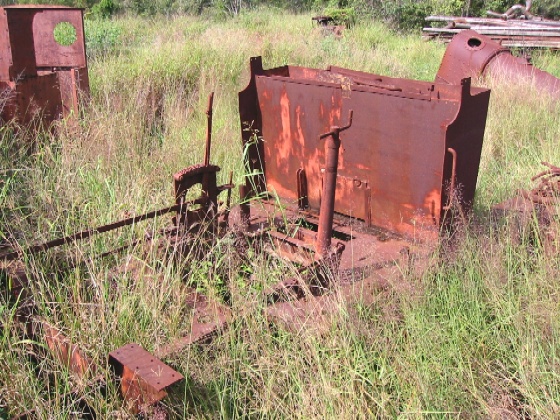|
|
Proserpine Mill No.6 Stored dismantled at Narangba |
|

The chassis of Bundy-Fowler No.8, seen lurking in the grass
at Kallangur on 12 April 2003.
The various other components large & small were stored nearby.
|
Bundaberg Foundry Engineers Ltd |
|
|
Builder’s Number & Year |
8 of 1953 |
|
Wheel Arrangement |
0-6-2T |
|
The Bundy Fowler locos The well-known manufacturer John Fowler &
Co, Leeds, UK built many steam locomotives for the Australian sugar cane
industry, where their products were held in high regard. In 1935, John Fowler
& Co made a strategic decision to cease manufacture of steam locomotives
in favour of internal combustion designs, leaving a market gap in the
Australian sugar industry where demand for steam traction remained. Stepping
in to fill this gap were Australian companies Perry Engineering in Adelaide,
and Bundaberg Foundry Engineers Ltd (Bundaberg Foundry) who leveraged their
established heavy engineering business serving the cane mills of Queensland’s
Burnett Region and beyond. By 1948, Bundaberg Foundry had obtained firm
orders from various mills for 8 steam locomotives based on recent John Fowler
& Co designs operating at Queensland mills, in particular 0-6-2T ‘Airdmillan’ (Fowler b/n 20763 of 1935), and with modernisations
such as roller-bearing axles. It seems a licence was eventually negotiated
with John Fowler & Co, but steel supply proved problematic in the
post-war years and the first loco was not completed until 1952. A single
0-4-2T version was among the 8 constructed. These antipodean Fowler cousins
became known as ‘Bundy Fowlers’ and were not only among the last steam
locomotives built in Australia, but also among the last in revenue service –
with all 8 Bundaberg-Fowler steam locomotives ultimately passing into
preservation. John Browning and Brian Webber have written a
comprehensive and well-illustrated account of the various steam and diesel
locomotives built and reconstructed by Bundaberg Foundry Engineers Limited in
‘Built by Bundaberg Foundry’ as referenced below. Rather than repeat the
information provided in that authorative work, I have sought here to provide
a brief background to the Bundy-Fowler steam locomotives and their
preservation careers. Proserpine Mill No.6 The eighth and last of the Bundy-Fowlers to
be built was delivered to Proserpine Sugar Mill, north of Mackay, where it
was initially No.8 until renumbered to No.6 in 1957. The loco was withdrawn
as early as 1961 as diesels had taken over all duties, and the loco was
subsequently stored at the Mill for many years. In the early 1980’s a plan was devised to
restore the loco to operation as an apprentice training project at Proserpine
Mill. Unfortunately, the project was abandoned in 1982 when it was discovered
that expensive firebox repairs were needed. By that stage the loco had been
fully dismantled for overhaul – and so it has remained ever since. In 1986 the loco was offered for sale, and
Proserpine Mill No.6 was privately purchased, still fully dismantled, and
moved by the current owner for storage at his manufacturing workshop at
Kallangur, north of Brisbane. The owner kindly showed me his steam collection
at Kallangur on 12 April 2003 and the photo on this page date from that
visit. Proserpine Mill No.6 was found dismantled with the frames, boiler and
side tanks stored around the site. The owner commented that virtually all
fittings were available and in good order. The industrial premises at Kallangur /
Murrumba Downs were sold for redevelopment around 2007, with Proserpine Mill
No.6 and other steam relics at the site transferred to a new business
location in Narangba. Alas the owner has since passed away, and some of the
collection has since been sold to enthusiasts for restoration. As for this
Bundy Fowler loco, it has now been stored as a dismantled kit of parts for
much longer than it was ever in service! Perhaps a fitting future home for this loco
might be the Australian Sugar Cane Railway in the Botanical Gardens, who hold
two other Bundy Fowler locos in their collection – and hence any future
restoration of Proserpine Mill No.6 could benefit from both their expertise
and also an option to exchange parts. |
References
|
a |
Light
Railway Research Society of Australia Inc. Web site (Retrieved
3 November 2018): 'Preserved
Australian Sugar Cane Locomotives' list by John Browning |
|
b |
Website for Bundaberg Walkers Engineering
Ltd, retrieved
12 September 2022 |
|
c |
Browning J.
& Webber B. ‘Built
by Bundaberg Foundry’, published 2012 by the Australian
Narrow Gauge Railway Museum Society, Woodford QLD ISBN
978-0-9596009-4-0 |
|
d |
Information provided by Mr. G. Chapman during our meeting of 12 April 2003. |
|
e |
Information provided by John Browning via email dated 26 July 2009. |
Page updated: 11 December 2022
|
Government Railways: |
|
|||||||||
|
Private & Industrial Railways: |
|